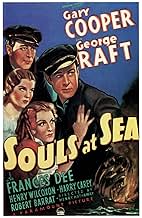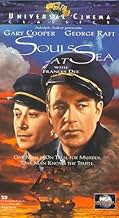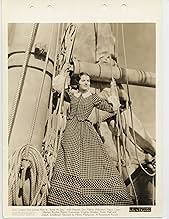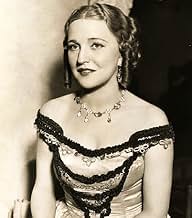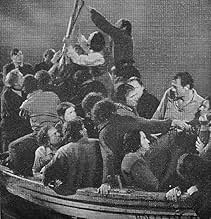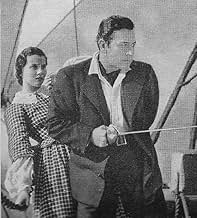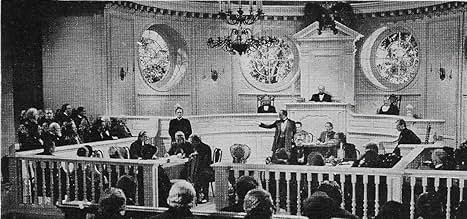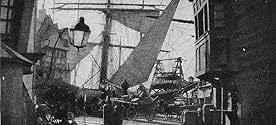IMDb-BEWERTUNG
6,8/10
943
IHRE BEWERTUNG
Füge eine Handlung in deiner Sprache hinzuCooper and Raft save lives during a sea tragedy in this story about slave trade on the high seas in 1842.Cooper and Raft save lives during a sea tragedy in this story about slave trade on the high seas in 1842.Cooper and Raft save lives during a sea tragedy in this story about slave trade on the high seas in 1842.
- Regie
- Drehbuch
- Hauptbesetzung
- Für 3 Oscars nominiert
- 3 Gewinne & 3 Nominierungen insgesamt
Norman Ainsley
- Ticket Taker
- (Nicht genannt)
Empfohlene Bewertungen
Gary Cooper (Nuggin) is on trial for manslaughter at sea. He is accused of playing God and deciding who lives and who dies on a sinking ship in the Atlantic Ocean. The verdict is pronounced and then George Zucco (Woodley) steps forward to give a statement and we head into flashback for the film's story. It is one that is set on the seas and involves slavery versus anti-slavery, romance and is partly a buddy-buddy movie with Cooper and his friend George Raft (Powdah). There is also tragedy and the story is based on an incident that set a precedent in maritime law.
It's an entertaining film with twists as to who is doing what so pay attention. It also has an interesting angle due to the legal significance of the story, and all the cast play their roles well. If you take note at the beginning of the film during the prosecutor's speech in the court case, he mentions some of those who didn't survive the tragedy. We will be introduced to these characters when the film moves onto the doomed ship.
Would you throw people out of a lifeboat to ensure the survival of at least some of them rather than the death of all of them? Every man for himself or do passengers come first? Why not just fly instead?
It's an entertaining film with twists as to who is doing what so pay attention. It also has an interesting angle due to the legal significance of the story, and all the cast play their roles well. If you take note at the beginning of the film during the prosecutor's speech in the court case, he mentions some of those who didn't survive the tragedy. We will be introduced to these characters when the film moves onto the doomed ship.
Would you throw people out of a lifeboat to ensure the survival of at least some of them rather than the death of all of them? Every man for himself or do passengers come first? Why not just fly instead?
Souls at Sea (SAS) is an unusual film from Gary Cooper's peak years with Paramount Studios. It is obscure and hard to find. However, SAS is now available on YouTube, so those who are unfamiliar with it now have the rare opportunity to judge its merits for themselves.
SAS was originally planned to be a much more important film than the one we now have before us. Somewhere along the way, Paramount abandoned its ambitions for SAS. What eventually emerged, while hardly an epic, is an interesting entertainment that deals with important issues and deserves a larger audience.
The plot considers a back story involving the notorious slave trade that persisted into the nineteenth century, and the efforts by some individuals to take matters into their own hands to curtail the practice. But the more important part of the film deals with an unexpected shipwreck and the resulting inadequate lifeboat space available to accommodate its survivors. Cooper as the first mate faces the incredible dilemma of suddenly having to "play God" and determine which survivors must be sacrificed in an effort to save the lives of all the others.
This part of the story is based on fact. The actual case, U. s. v. Holmes, is a famous Supreme Court precedent known to anyone familiar with Criminal Law and the legal subject of homicide. Holmes, the first mate, was actually tried for manslaughter in connection with the deaths of those he consigned to die hoping to save the rest of the survivors. Was the defense of justifiable homicide available to Holmes under these facts? The legal answer was no. However, shortly after he had been found guilty of manslaughter, Holmes was freed from imprisonment. So what does the case stand for? Legal scholars argue about it to this day.
SAS presents the Holmes case in a fictional setting, yet it retains a similar ending. The Cooper character, now called Taylor, is set free after his trial. But the circumstances of this development may be more the result of his involvement in the back story of the plot than in the moral and ethical quandary of having to "play God" with the lives of innocent people to save others who might otherwise have perished.
For another take on the Holmes story, check out the Tyrone Power British film Seven Waves Away/Abandon Ship! (1957).
SAS has an extraordinary cast of supporting actors and splendid camera work--particularly in the climactic sequence involving the shipwreck. Cooper and George Raft make a surprisingly good "buddy" pairing, and SAS provides a rare opportunity to see the exotic beauty Olympe Bradna in one of her few Hollywood films.
All in all, SAS is a film that is well worth seeing, and deserves a wider audience than it now enjoys.
SAS was originally planned to be a much more important film than the one we now have before us. Somewhere along the way, Paramount abandoned its ambitions for SAS. What eventually emerged, while hardly an epic, is an interesting entertainment that deals with important issues and deserves a larger audience.
The plot considers a back story involving the notorious slave trade that persisted into the nineteenth century, and the efforts by some individuals to take matters into their own hands to curtail the practice. But the more important part of the film deals with an unexpected shipwreck and the resulting inadequate lifeboat space available to accommodate its survivors. Cooper as the first mate faces the incredible dilemma of suddenly having to "play God" and determine which survivors must be sacrificed in an effort to save the lives of all the others.
This part of the story is based on fact. The actual case, U. s. v. Holmes, is a famous Supreme Court precedent known to anyone familiar with Criminal Law and the legal subject of homicide. Holmes, the first mate, was actually tried for manslaughter in connection with the deaths of those he consigned to die hoping to save the rest of the survivors. Was the defense of justifiable homicide available to Holmes under these facts? The legal answer was no. However, shortly after he had been found guilty of manslaughter, Holmes was freed from imprisonment. So what does the case stand for? Legal scholars argue about it to this day.
SAS presents the Holmes case in a fictional setting, yet it retains a similar ending. The Cooper character, now called Taylor, is set free after his trial. But the circumstances of this development may be more the result of his involvement in the back story of the plot than in the moral and ethical quandary of having to "play God" with the lives of innocent people to save others who might otherwise have perished.
For another take on the Holmes story, check out the Tyrone Power British film Seven Waves Away/Abandon Ship! (1957).
SAS has an extraordinary cast of supporting actors and splendid camera work--particularly in the climactic sequence involving the shipwreck. Cooper and George Raft make a surprisingly good "buddy" pairing, and SAS provides a rare opportunity to see the exotic beauty Olympe Bradna in one of her few Hollywood films.
All in all, SAS is a film that is well worth seeing, and deserves a wider audience than it now enjoys.
Everything is excellent here. Gary Cooper makes one of his great character roles of double depths, George Raft makes for once a great contribution, all the characters are natural and organic, the realism is magnificent, the glory of the era of the sailing ships is enhanced and lifted out of the screen, and even the music is perfect, with many glorious moments of innovation and good humour, and the quality of the drama, both human and natural, is undeniable in its realisation with a formidable shipwreck to crown the masterpiece. Henry Hathaway knew his business thoroughly, he never committed mistakes, and this is just one of his many masterpieces.
Some of the events in "Souls at Sea" were inspired by a shipwreck in about 1840. However, despite appearances, it's clearly a highly fictionalized version of history and really doesn't claim to be a true story.
When the story begins, Nuggin (Gary Cooper) and Powdah* (George Raft) are serving aboard a slave ship. Although slavery was still legal in the States, it was illegal to import slaves...and the British navy enforced a blackade of slavers. If they caught them, the men serving aboard the slave ships were prosecuted...so you'd assume that the two men are evil. But you cannot have a film with slavers being the heroes...even back in 1937. Well, it turns out that Nuggin is actually working on his own as an anti-slaver....and he's had a history of scuttling these ships and setting the poor slaves free. As a result, he is made an undercover operative for the British...and his task involves getting to America as soon as possible to set a trap for other slave ships. But Nuggin's arch nemesis (Henry Wilcoxon) is also bound for the States to stop him...and they're aboard the same ship! What's next? Well, a lot!!
Apart from an interesting plot, the film benefits from good acting and some amazing shipwreck scenes....truly spectacular. Overall, a wonderful adventure film that isn't perfect (Raft seemed mostly wasted and in the way during most of the film), but is nevertheless well worth seeing.
* Who thought of these insane names?! Huh!??!
When the story begins, Nuggin (Gary Cooper) and Powdah* (George Raft) are serving aboard a slave ship. Although slavery was still legal in the States, it was illegal to import slaves...and the British navy enforced a blackade of slavers. If they caught them, the men serving aboard the slave ships were prosecuted...so you'd assume that the two men are evil. But you cannot have a film with slavers being the heroes...even back in 1937. Well, it turns out that Nuggin is actually working on his own as an anti-slaver....and he's had a history of scuttling these ships and setting the poor slaves free. As a result, he is made an undercover operative for the British...and his task involves getting to America as soon as possible to set a trap for other slave ships. But Nuggin's arch nemesis (Henry Wilcoxon) is also bound for the States to stop him...and they're aboard the same ship! What's next? Well, a lot!!
Apart from an interesting plot, the film benefits from good acting and some amazing shipwreck scenes....truly spectacular. Overall, a wonderful adventure film that isn't perfect (Raft seemed mostly wasted and in the way during most of the film), but is nevertheless well worth seeing.
* Who thought of these insane names?! Huh!??!
Although not in the same lofty class as William Wyler, Alfred Hitchcock, Billy Wilder or Fred Zinnemann, Henry Hathaway remains one of my favorite Hollywood directors. I particularly like CALL NORTHSIDE 777, RAWHIDE and NIAGARA, but will quickly add that I found SOULS AT SEA a gem.
For starters, Gary Cooper and Frances Dee were at the height of their physical beauty, in addition to punching in terrific performances - Cooper always with a comic touch, Dee delightful in every nuance of her lovely eyes.
They are ably seconded by George Raft, Cooper's chum and a rather uneducated but senior shiphand who picks up some cultural pointers from Cooper and ends with sensitive, even sentimental moments.
Terrific enmical exchanges between Cooper and Henry Wilcoxon as Dee's devious brother. The two have issues over slavery, which the former actively sabotages and the latter sees as a major income opportunity.
Glorious B&W cinematography from Merrit Gerstad and Charles Lang, with terrific sequences at sea, notably as the little girl inadvertently starts a fire and the bad ship William Brown goes down.
The screenplay by Grover Jones and Dale Van Every includes some highly comic scenes, such as when Cooper, Dee and Wilcoxon all have hiccups at the same time, some very touching ones between Raft and love interest Olympe Bradna, and some very tragic decisions that Cooper has to make as the ship sinks.
Despite narrative ups and downs, the production values are very high, and the film remains engrossing throughout. 7/10.
For starters, Gary Cooper and Frances Dee were at the height of their physical beauty, in addition to punching in terrific performances - Cooper always with a comic touch, Dee delightful in every nuance of her lovely eyes.
They are ably seconded by George Raft, Cooper's chum and a rather uneducated but senior shiphand who picks up some cultural pointers from Cooper and ends with sensitive, even sentimental moments.
Terrific enmical exchanges between Cooper and Henry Wilcoxon as Dee's devious brother. The two have issues over slavery, which the former actively sabotages and the latter sees as a major income opportunity.
Glorious B&W cinematography from Merrit Gerstad and Charles Lang, with terrific sequences at sea, notably as the little girl inadvertently starts a fire and the bad ship William Brown goes down.
The screenplay by Grover Jones and Dale Van Every includes some highly comic scenes, such as when Cooper, Dee and Wilcoxon all have hiccups at the same time, some very touching ones between Raft and love interest Olympe Bradna, and some very tragic decisions that Cooper has to make as the ship sinks.
Despite narrative ups and downs, the production values are very high, and the film remains engrossing throughout. 7/10.
Wusstest du schon
- WissenswertesWhen Nuggin and Powdah are in a tavern, the bartender immerses a hot iron into their beer mugs. This was most likely part of making a popular sailor's drink at the time called a "flip". It was made with beer, rum, sugar or molasses (and possibly a spice like cinnamon or cloves). The hot poker caramelizes the sugar. The technique was also just a quick way to warm beer during the winter.
- PatzerReading Hamlet aloud, Gary Cooper says, "the thousand natural shocks that the flesh is heir to." The second "the" is a mistake--it spoils the scansion.
- Zitate
Michael 'Nuggin' Taylor: The floor of the ocean is paved with the bones of slaves.
- VerbindungenReferenced in Kein Platz für Eltern (1937)
- SoundtracksSusie Sapple
(1937) (uncredited)
Music by Ralph Rainger
Lyrics by Leo Robin
Performed by George Raft and Gary Cooper
Top-Auswahl
Melde dich zum Bewerten an und greife auf die Watchlist für personalisierte Empfehlungen zu.
- How long is Souls at Sea?Powered by Alexa
Details
- Laufzeit
- 1 Std. 32 Min.(92 min)
- Farbe
- Seitenverhältnis
- 1.37 : 1
Zu dieser Seite beitragen
Bearbeitung vorschlagen oder fehlenden Inhalt hinzufügen

